Attached files
| file | filename |
|---|---|
| 8-K - 8-K - PINNACLE WEST CAPITAL CORP | form8-kseptember262017inve.htm |
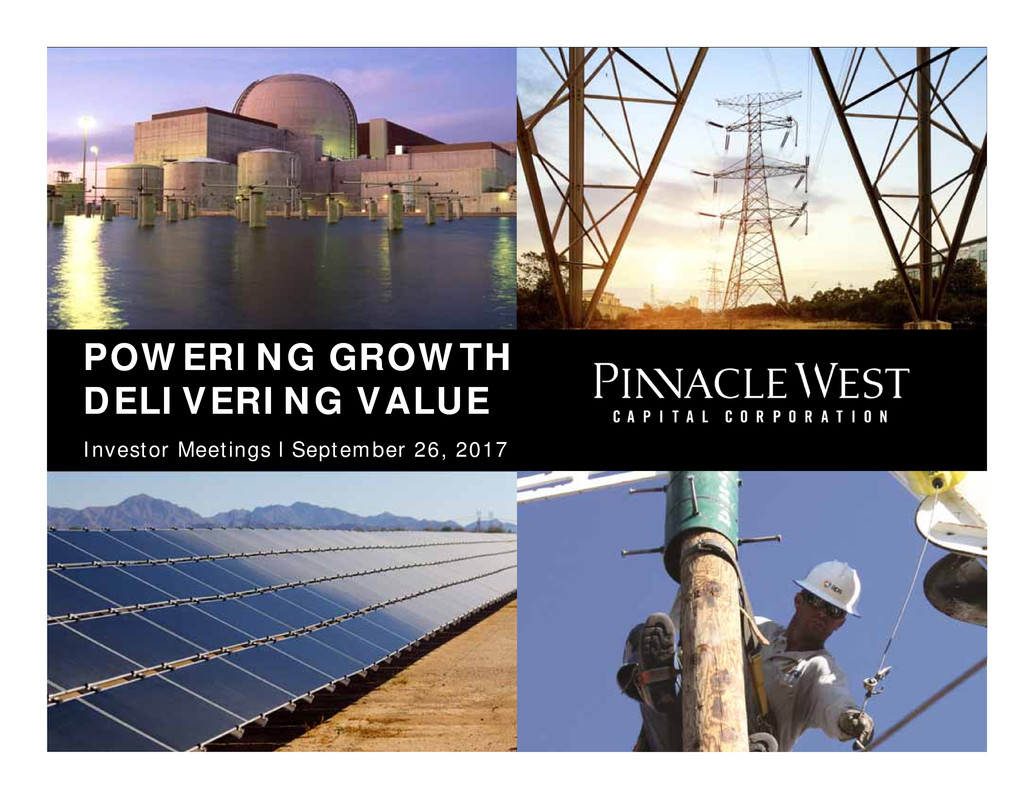
Powering Growth, Delivering Value1
Investor Meetings l September 26, 2017
POWERING GROWTH
DELIVERING VALUE
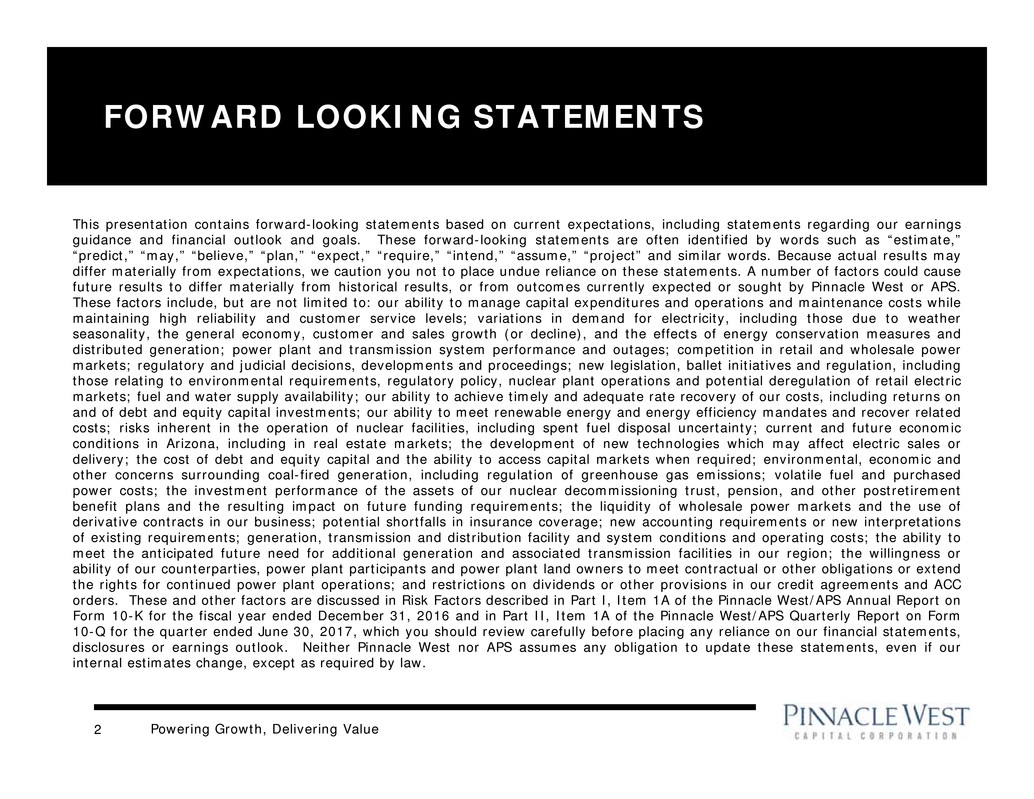
Powering Growth, Delivering Value2
FORWARD LOOKING STATEMENTS
This presentation contains forward-looking statements based on current expectations, including statements regarding our earnings
guidance and financial outlook and goals. These forward-looking statements are often identified by words such as “estimate,”
“predict,” “may,” “believe,” “plan,” “expect,” “require,” “intend,” “assume,” “project” and similar words. Because actual results may
differ materially from expectations, we caution you not to place undue reliance on these statements. A number of factors could cause
future results to differ materially from historical results, or from outcomes currently expected or sought by Pinnacle West or APS.
These factors include, but are not limited to: our ability to manage capital expenditures and operations and maintenance costs while
maintaining high reliability and customer service levels; variations in demand for electricity, including those due to weather
seasonality, the general economy, customer and sales growth (or decline), and the effects of energy conservation measures and
distributed generation; power plant and transmission system performance and outages; competition in retail and wholesale power
markets; regulatory and judicial decisions, developments and proceedings; new legislation, ballet initiatives and regulation, including
those relating to environmental requirements, regulatory policy, nuclear plant operations and potential deregulation of retail electric
markets; fuel and water supply availability; our ability to achieve timely and adequate rate recovery of our costs, including returns on
and of debt and equity capital investments; our ability to meet renewable energy and energy efficiency mandates and recover related
costs; risks inherent in the operation of nuclear facilities, including spent fuel disposal uncertainty; current and future economic
conditions in Arizona, including in real estate markets; the development of new technologies which may affect electric sales or
delivery; the cost of debt and equity capital and the ability to access capital markets when required; environmental, economic and
other concerns surrounding coal-fired generation, including regulation of greenhouse gas emissions; volatile fuel and purchased
power costs; the investment performance of the assets of our nuclear decommissioning trust, pension, and other postretirement
benefit plans and the resulting impact on future funding requirements; the liquidity of wholesale power markets and the use of
derivative contracts in our business; potential shortfalls in insurance coverage; new accounting requirements or new interpretations
of existing requirements; generation, transmission and distribution facility and system conditions and operating costs; the ability to
meet the anticipated future need for additional generation and associated transmission facilities in our region; the willingness or
ability of our counterparties, power plant participants and power plant land owners to meet contractual or other obligations or extend
the rights for continued power plant operations; and restrictions on dividends or other provisions in our credit agreements and ACC
orders. These and other factors are discussed in Risk Factors described in Part I, Item 1A of the Pinnacle West/APS Annual Report on
Form 10-K for the fiscal year ended December 31, 2016 and in Part II, Item 1A of the Pinnacle West/APS Quarterly Report on Form
10-Q for the quarter ended June 30, 2017, which you should review carefully before placing any reliance on our financial statements,
disclosures or earnings outlook. Neither Pinnacle West nor APS assumes any obligation to update these statements, even if our
internal estimates change, except as required by law.

Powering Growth, Delivering Value3
PINNACLE WEST:
WHO WE ARE
We are a vertically integrated,
regulated electric utility in the
growing southwest United States
Pinnacle West (NYSE: PNW)
- Market Capitalization*: $10.0 billion
- Enterprise Value*: $15.0 billion
- Consolidated Assets: $16.7 billion
- Indicated Annual Dividend*: $2.62
- Dividend Yield*: 2.9%
Principal subsidiary:
- Arizona Public Service Company, Arizona’s largest
and longest-serving electric utility
Customers: 1.2 million (89% residential)
2017 YTD Peak Demand: 7,367 MW
- Previous all time high of 7,236 in July 2006
Generation Capacity: About 6,200 MW of owned or
leased capacity (~8,600 MW with long-term contracts)
- Including 29.1% interest in Palo Verde Generating
Station, the largest nuclear plant in the U.S.
- Regulated utility provides stable, regulated
earnings and cash flow base for Pinnacle West
* As of September 15, 2017

Powering Growth, Delivering Value4
VALUE PROPOSITION
We are executing on our financial and operational objectives …
Operational Excellence
Top decile safety performance
among peers
APS operates the Palo Verde
Generating Station
Disciplined cost management
Financial Strength
Annual dividend growth target of
5%, subject to declaration at
Board of Directors discretion
Strong credit ratings and balance
sheet
Rate base growth of 6-7%
(2015-2019)
Leverage
Economic Growth
Arizona’s long-term growth
fundamentals remain largely
intact, including population
growth, job growth and economic
development
By 2032 we expect to add
550,000 new customers1
… while also advocating to ensure Pinnacle West and
Arizona have a sustainable energy future
Integrating Technology to
Modernize the Grid
At the forefront of utilities
studying and deploying advanced
infrastructure to enable reliable
and cost-efficient integration of
emerging technologies into the
grid and with customers
Taking Steps to Address
Rate Design
Worked with Arizona Corporation
Commission and key stakeholders
to modernize rates
Comprehensive rate review
agreement approved in August
2017, enabling investment in
smarter, cleaner energy
infrastructure
Pinnacle West combines
a solid foundation and a
clear strategy to build
shareholder value through
our core utility business
1 Based on the 2017 Integrated Resource Plan filed April 10, 2017.

Powering Growth, Delivering Value5
RENEWABLE
RESOURCES
APS is a leader in solar
Aragonne Mesa
Wind
90 MW
Snowflake
Biomass
14 MW
Glendale Landfill
Biogas
2.8 MW
Salton Sea
Geothermal
10 MW
• Solar* 1,197 MW
• Wind 289 MW
• Biomass 14 MW
• Geothermal 10 MW
• Biogas 6 MW
APS currently has 1,516 MW
of renewable resources:
Owned solar includes 170 MW AZ Sun Program, 4 MW of other APS
owned utility scale solar and 40 MW Red Rock Solar Plant;
Distributed Generation (DG) includes 25 MW of APS owned.
PPA is primarily 250 MW Solana Concentrated Solar Facility.
PPA
310 MW
DG
673 MW
Owned
214 MW
APS Solar Portfolio*
Yuma Foothills
Solar
35 MW
* As of Second Quarter 2017 Form 10-Q – with additional 67 MW under development

Powering Growth, Delivering Value6
BATTERY STORAGE
Energy storage is important but
will only be cost effective in niche
circumstances for the next several
years
APS Projects
– Punkin Center, Arizona: 2 X 4MWh Li-ion battery storage systems to be
installed in fall 2017 in place of rebuilding 20 miles of distribution lines
– Solar Innovation Study: Residential battery installations for purpose of
studying ability of solar-coupled systems to lower peak energy demand
– Solar Partner Program: 2 X 2MWh Li-ion battery storage systems – 1 at
substation, 1 mid-feeder, for purposes of researching battery effects on grid
and learning most efficient manner to operate
Distribution
Substation
Substation
Storage (Feeder 1)
Feeder-level
Storage (Feeder 2)

Powering Growth, Delivering Value7
THE GRID IS EVOLVING
Technology
Distributed
Energy
Resources
Economics
Public Policy

Powering Growth, Delivering Value8
SUMMARY
• Enabling customer choice
• Evolution in employee training
and capabilities
• Long-term vision
• Commitment to strategy
Device Deployment/
Training
Investment Benefits
Solving problems by improving
Visibility, Control, Mobility and
Human capabilities
Visibility Control
Mobility Human
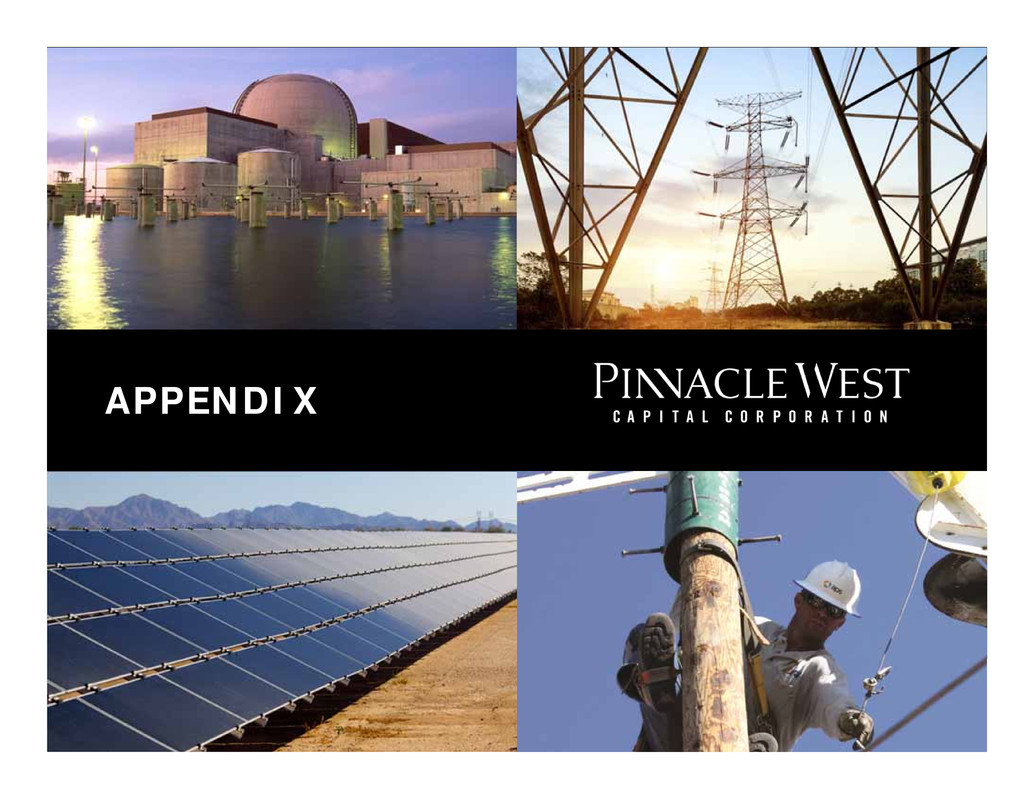
Powering Growth, Delivering Value9
APPENDIX

Powering Growth, Delivering Value10
LEADERSHIP TEAM
Our top executives have more
than 100 combined years of
creating shareholder value in the
energy industry
Don Brandt
Chairman & Chief
Executive Officer
Mark Schiavoni
EVP & Chief
Operating
Officer
Bob Bement
EVP & Chief
Nuclear Officer
Jim Hatfield
EVP & Chief
Financial
Officer
Jeff Guldner
EVP
Public Policy &
General
Counsel

Powering Growth, Delivering Value11
$221 $217 $246 $233
$79
$237 $119
$8
$220
$198
$106
$48
$102
$3
$17
$16
$127
$203
$170
$190
$388
$402
$409
$412
$87
$77
$72
$102
2016 2017 2018 2019
APS CAPITAL
EXPENDITURES
Capital expenditures are funded
primarily through internally
generated cash flow
($ Millions)
$1,224
$1,337
Other
Distribution
Transmission
Renewable
Generation
Environmental(1)
Traditional
Generation
Projected
$1,139
New Gas
Generation(2)
• The table does not include capital expenditures related to 4CA’s 7% interest in the Four Corners Power Plant Units 4 and 5 of
$30 million in 2016, $27 million in 2017, $15 million in 2018 and $6 million in 2019.
• 2017 – 2019 as disclosed in Second Quarter 2017 Form 10-Q.
(1) Includes Selective Catalytic Reduction controls at Four Corners with in-service dates of Q4 2017 (Unit 5) and Q1 2018 (Unit 4)
(2) Ocotillo Modernization Project: 2 units scheduled for completion in Q4 2018, 3 units scheduled for completion in Q1 2019
$1,009

Powering Growth, Delivering Value12
THE GRID IS EVOLVING – DRIVING NEW
INVESTMENTS IN TECHNOLOGY
Drivers for
Change
– Traditional grid built for
one-way flow
– Technology advancements
(storage, home energy
management)
– Changing customer needs and
demands
– Proliferation of distributed
solar energy, which does not
align with peak
The Modern
Grid
– New technologies to enable
two-way flow
– Proactive vs. reactive
operations and maintenance
– Modern rate structure
– New ways to interact with
customer
– Mobility for our field personnel
– Smarter, more flexible real-
time system operations
– Support consumer products
and services
– Addresses cybersecurity
APS Laying
Foundation for
the Future
– Solar R&D initiatives
• Solar Partner Program
• Solar Innovation Study
– Smart meters fully deployed
– Investing in peaking capacity upgrades
(Ocotillo)
– Evaluating storage/customer-cited
technology
• Battery pilot investments
• Microgrids
– Software upgrades for distribution
operations and customer service
– Ensuring our people have the relevant
skill sets
• Grid stability, power quality and reliability remain the core of a sustainable electrical system
• APS is at the forefront of utilities designing and planning for the next generation electric grid
• New technology advances and changing customer needs are transforming the way we use the grid

Powering Growth, Delivering Value13
DISTRIBUTION GRID
INVESTMENTS
Modernizing the distribution grid
with advanced technology
investments – resulting in
improved reliability for customers
and more efficient operations
Integrated Volt/VAR Control (IVVC)
Smart Meters
Advanced Distribution Management System
Strategic Fiber
Supervisory Controlled Switches
Substation Health Monitoring
Controls regulators and
capacity banks to manage
power quality such as power
factor and voltage.
New technologies such as
APS’s Transformer Oil
Analysis & Notification
(TOAN) system leverage
advances in
communications and
sensing to remotely monitor
heath of transformers,
enabling proactive
maintenance actions to
prevent critical failures.
Automated switches that
can be controlled from
Distribution Operations
Center (DOC). Allows
operations to manage
load without sending
field personnel to
manually operate the
switch.
Integrated operational
platform. Increases
efficiency and life of
distribution system;
improves safety and
communication; increases
ability to manage overall
reliability; and enables
Distributed Energy
Resources (DER).
Grid Operations & Investment
$1.2 Billion over next 3 years
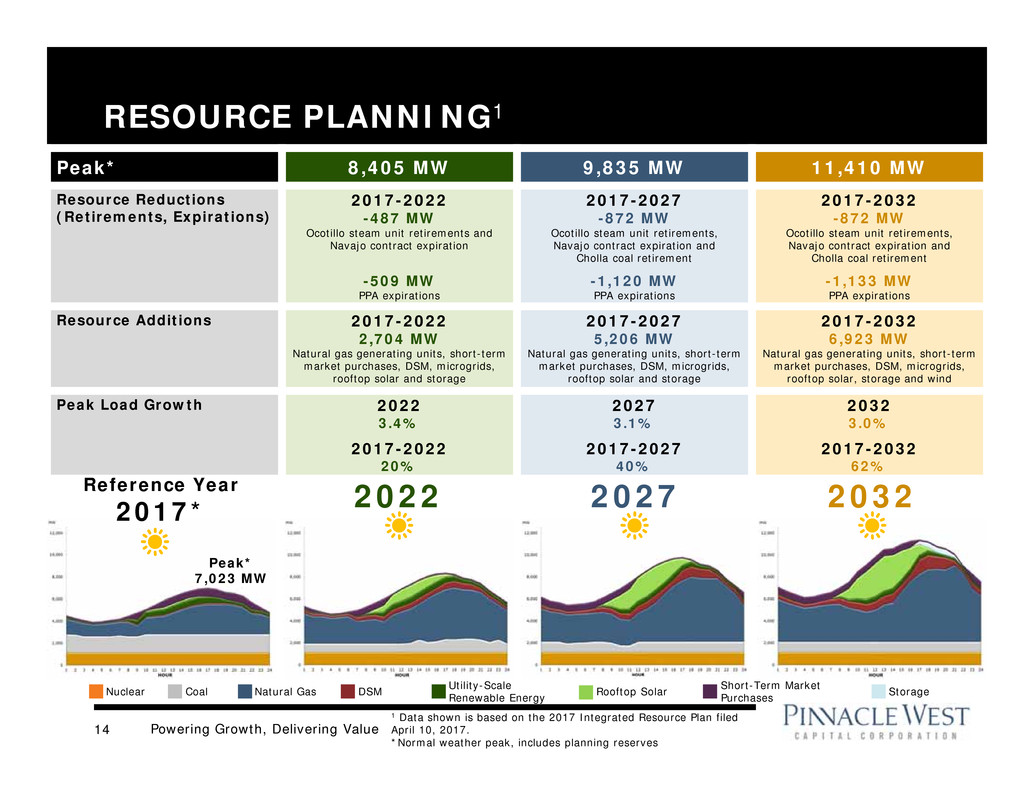
Powering Growth, Delivering Value14
Peak* 8,405 MW 9,835 MW 11,410 MW
Resource Reductions
(Retirements, Expirations)
2017-2022
-487 MW
Ocotillo steam unit retirements and
Navajo contract expiration
-509 MW
PPA expirations
2017-2027
-872 MW
Ocotillo steam unit retirements,
Navajo contract expiration and
Cholla coal retirement
-1,120 MW
PPA expirations
2017-2032
-872 MW
Ocotillo steam unit retirements,
Navajo contract expiration and
Cholla coal retirement
-1,133 MW
PPA expirations
Resource Additions 2017-2022
2,704 MW
Natural gas generating units, short-term
market purchases, DSM, microgrids,
rooftop solar and storage
2017-2027
5,206 MW
Natural gas generating units, short-term
market purchases, DSM, microgrids,
rooftop solar and storage
2017-2032
6,923 MW
Natural gas generating units, short-term
market purchases, DSM, microgrids,
rooftop solar, storage and wind
Peak Load Growth 2022
3.4%
2017-2022
20%
2027
3.1%
2017-2027
40%
2032
3.0%
2017-2032
62%
RESOURCE PLANNING1
*Normal weather peak, includes planning reserves
2022
Nuclear Coal Natural Gas DSM Utility-Scale Renewable Energy Rooftop Solar
Short-Term Market
Purchases Storage
1 Data shown is based on the 2017 Integrated Resource Plan filed
April 10, 2017.
2027 2032Reference Year 2017*
Peak*
7,023 MW

Powering Growth, Delivering Value15
• 10-Year Transmission Plan filed January
2017 (115 kV and above)
– 52 miles of new lines
– 5 bulk transformer additions
• Also includes:
– Sun Valley-Morgan 500kV (2018)
– North Gila-Orchard 230kV (2021)
• 2 of 3 Projects to deliver renewable energy
approved by ACC have been completed
• Transmission investment diversifies
regulatory risk
– Constructive regulatory treatment
– FERC formula rates and retail adjustor
APS TRANSMISSION
Strategic transmission investment
is essential to maintain reliability
and deliver diversified resources
to customers
Legend
Planned lines
Existing lines
Solar potential area
Wind potential area
Phoenix
Flagstaff
Tucson

Powering Growth, Delivering Value16
249 357 339
442 610
710 641
783 871
939
523
836
484
680 832 715
1,157 1,158
1,349
1,141 1,002
1,189
1,077
1,168
1,154
760
1,267
1,003
1,291 1,414 1,369
2,043
1,632
1,474
1,325
1,4721,469 1,593
1,865 1,996
2,535
3,910
2,412
4,045
0
500
1,000
1,500
2,000
2,500
3,000
3,500
4,000
4,500
Jan Feb Mar Apr May Jun Jul Aug Sep Oct Nov Dec
2014 Applications 2015 Applications 2016 Applications 2017 Applications
* Monthly data equals applications received minus cancelled applications. As of August 31, 2017, approximately 66,000
residential grid-tied solar photovoltaic (PV) systems have been installed in APS’s service territory, totaling more than 510
MWdc of installed capacity. Excludes APS Solar Partner Program residential PV systems.
Note: www.arizonagoessolar.org logs total residential application volume, including cancellations. Solar water heaters can also be found
on the site, but are not included in the chart above.
RESIDENTIAL PV
APPLICATIONS* 10 18 22 44 51
57
74
133
97
2009 2011 2013 2015 2017
Residential DG (MWdc) Annual Additions
YTD -Aug
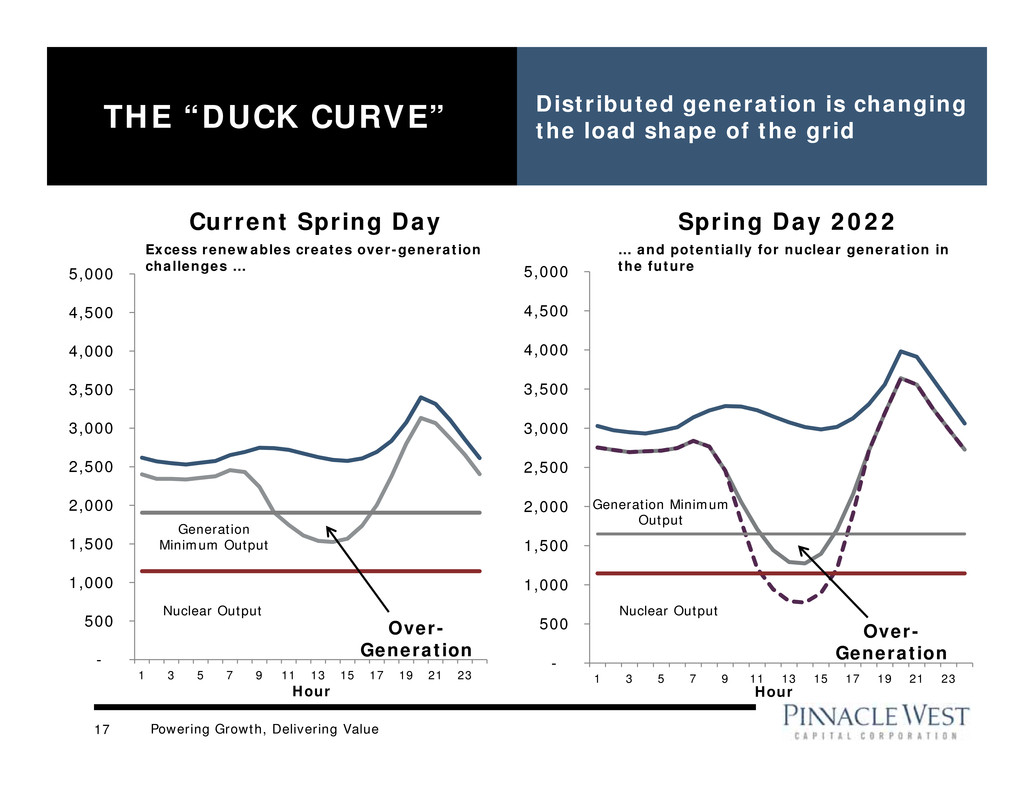
Powering Growth, Delivering Value17
-
500
1,000
1,500
2,000
2,500
3,000
3,500
4,000
4,500
5,000
1 3 5 7 9 11 13 15 17 19 21 23
Over-
Generation
Generation
Minimum Output
-
500
1,000
1,500
2,000
2,500
3,000
3,500
4,000
4,500
5,000
1 3 5 7 9 11 13 15 17 19 21 23
Generation Minimum
Output
Over-
Generation
THE “DUCK CURVE” Distributed generation is changing the load shape of the grid
Excess renewables creates over-generation
challenges …
Hour Hour
… and potentially for nuclear generation in
the future
Current Spring Day Spring Day 2022
Nuclear Output Nuclear Output
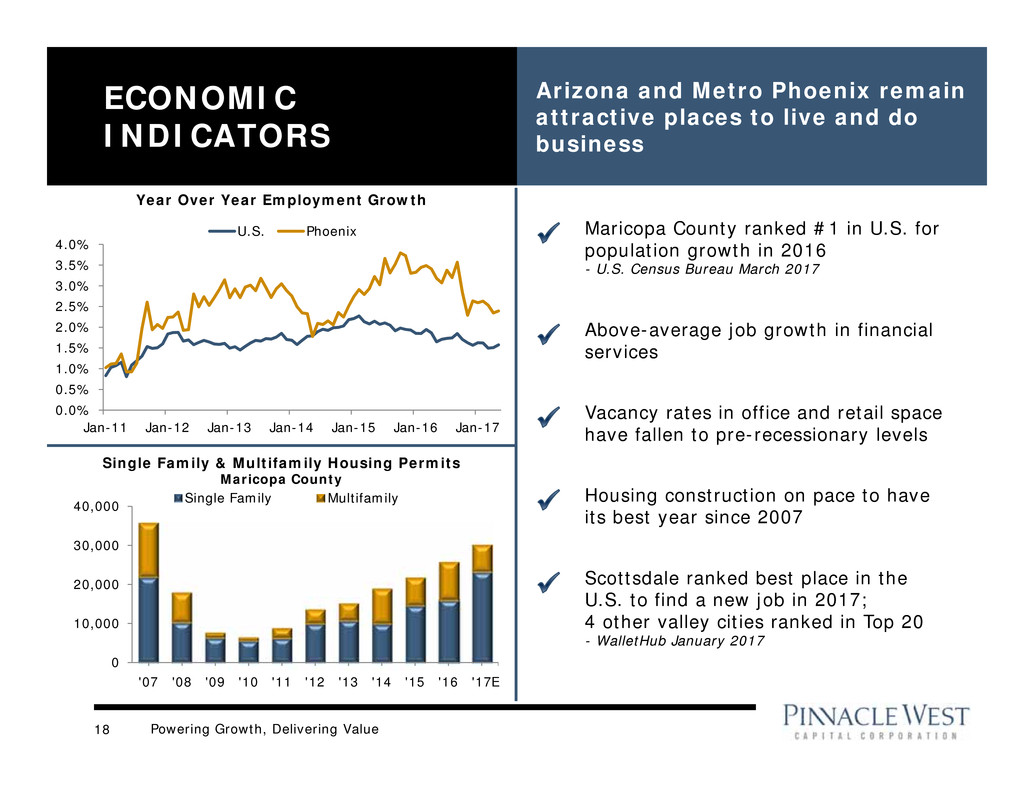
Powering Growth, Delivering Value18
0
10,000
20,000
30,000
40,000
'07 '08 '09 '10 '11 '12 '13 '14 '15 '16 '17
Single Family Multifamily
ECONOMIC
INDICATORS
Arizona and Metro Phoenix remain
attractive places to live and do
business
Single Family & Multifamily Housing Permits
Maricopa County
Above-average job growth in financial
services
Maricopa County ranked #1 in U.S. for
population growth in 2016
- U.S. Census Bureau March 2017
E
Scottsdale ranked best place in the
U.S. to find a new job in 2017;
4 other valley cities ranked in Top 20
- WalletHub January 2017
Housing construction on pace to have
its best year since 2007
Vacancy rates in office and retail space
have fallen to pre-recessionary levels
Year Over Year Employment Growth
0.0%
0.5%
1.0%
1.5%
2.0%
2.5%
3.0%
3.5%
4.0%
Jan-11 Jan-12 Jan-13 Jan-14 Jan-15 Jan-16 Jan-17
U.S. Phoenix

Powering Growth, Delivering Value19
RESIDENTIAL SOLAR
VS. APS CUSTOMER
LOAD
Performance at system peak
On June 20th, APS customers hit “peak demand” for 2017 using more than 7,300 MW of electricity
304
100
5
6,136
7,367
6,918
0
2,000
4,000
6,000
8,000
0
100
200
300
400
500
1 2 3 4 5 6 7 8 9 10 11 12 13 14 15 16 17 18 19 20 21 22 23 24
M
W
Hour Ending
Residential Rooftop
APS Customer Load
• 1-2 PM: Customer demand still increasing; rooftop solar peaks and begins to decline
• 5-6 PM: Between 5-6 pm, when customer demand reaches peak, rooftop solar producing at
approximately 30% of total capacity
• 8 PM: Rooftop output near zero, but customer demand still above 6,900 MW of power

Powering Growth, Delivering Value20
OPERATIONS &
MAINTENANCE
Goal is to keep O&M per kWh flat,
adjusted for planned outages
$761 $788
$805 $772
$828
$124
$137 $103
$96
$83 $80
2012 2013 2014 2015 2016 2017E
PNW Consolidated RES/DSM*
$830 -
$850
*Renewable energy and demand side management expenses are offset by adjustment mechanisms.
($ Millions)

Powering Growth, Delivering Value21
DIVIDEND GROWTH
Pinnacle West’s indicated annual
dividend is $2.62 per share;
targeting ~5% annual dividend
growth
$2.10
$2.18
$2.27
$2.38
$2.50
$2.62
2011 2012 2013 2014 2015 2016 2017 2018
Dividend Growth Goal
Indicated Annual Dividend Rate at Year-End
Projected
Future dividends subject to declaration at Board of Directors’ discretion.
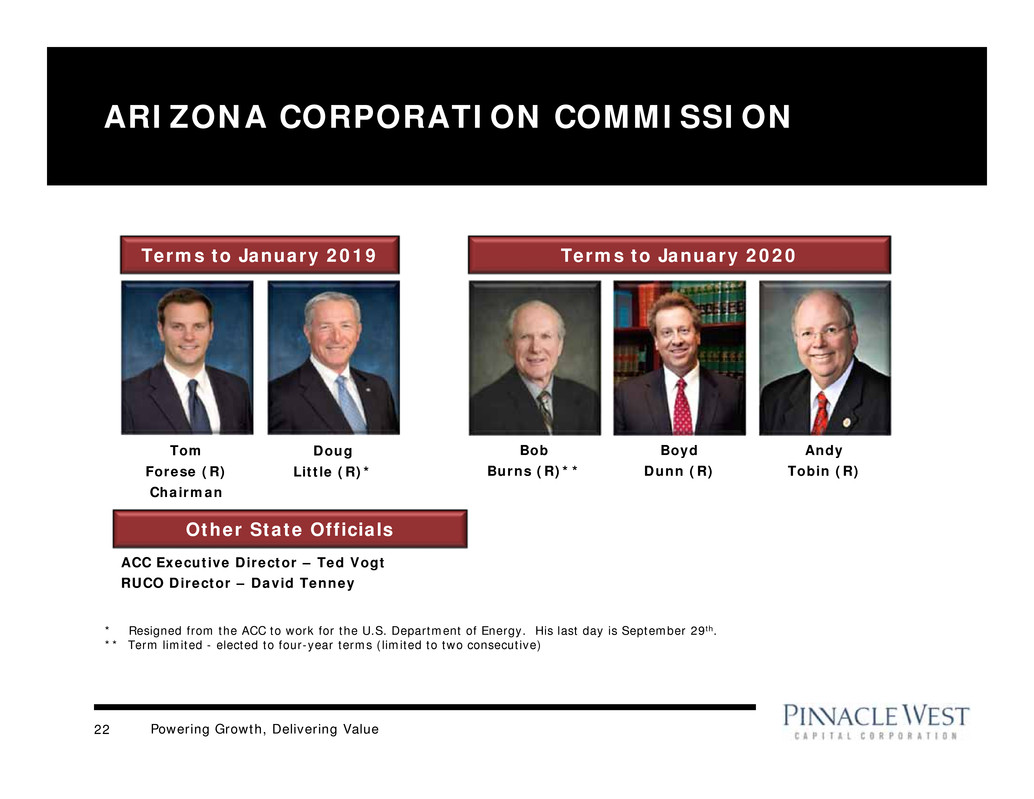
Powering Growth, Delivering Value22
Terms to January 2019
Other State Officials
ARIZONA CORPORATION COMMISSION
* Resigned from the ACC to work for the U.S. Department of Energy. His last day is September 29th.
** Term limited - elected to four-year terms (limited to two consecutive)
Tom
Forese (R)
Chairman
Doug
Little (R)*
ACC Executive Director – Ted Vogt
RUCO Director – David Tenney
Terms to January 2020
Bob
Burns (R)**
Andy
Tobin (R)
Boyd
Dunn (R)

Powering Growth, Delivering Value23
2017 RATE CASE ORDER*
EFFECTIVE AUGUST 19, 2017
Key Financial Proposals – Base Rate Changes
Annualized Base Rate Revenue Changes ($ millions)
Non-fuel, Non-depreciation Base Rate Increase $ 87.2
Decrease fuel and Purchased Power over Base Rates (53.6)
Increase due to Changes in Depreciation Schedules 61.0
Total Base Rate Increase $ 94.6
Key Financial Assumptions
Allowed Return on Equity 10.0%
Capital Structure
Long-term debt 44.2%
Common equity 55.8%
Base Fuel Rate (¢/kWh) 3.0168
Post-test year plant period 12 months
*The ACC’s decision is subject to requests for rehearing and
potential appeal.
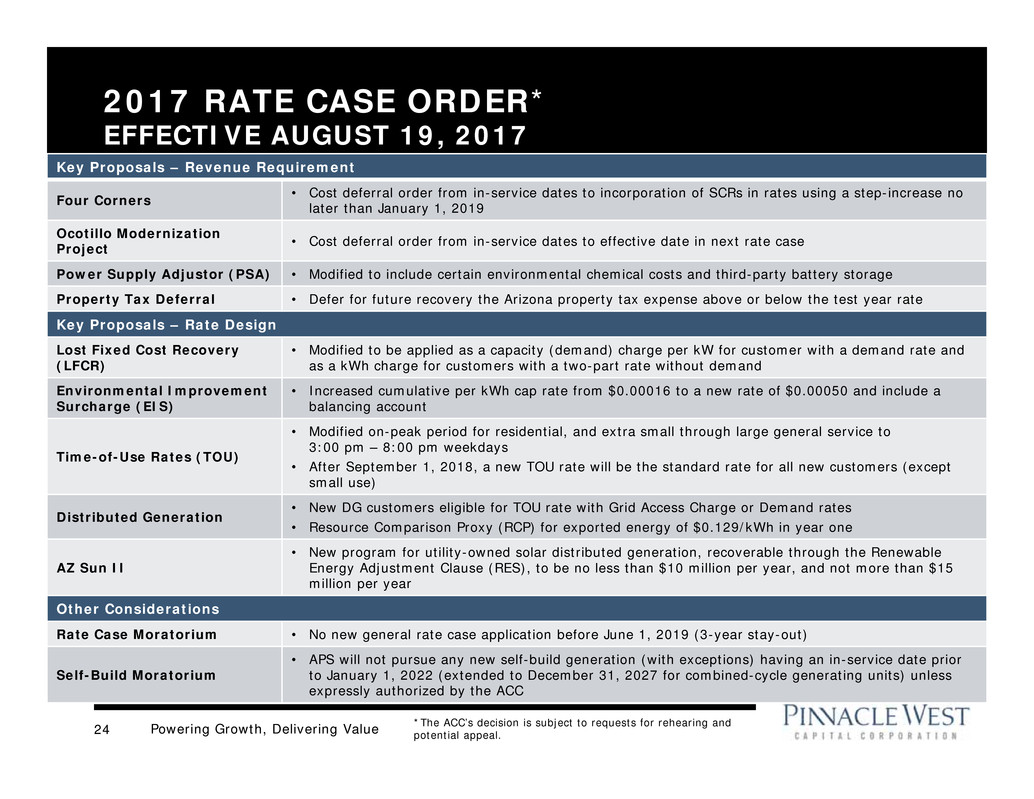
Powering Growth, Delivering Value24
Key Proposals – Revenue Requirement
Four Corners • Cost deferral order from in-service dates to incorporation of SCRs in rates using a step-increase no later than January 1, 2019
Ocotillo Modernization
Project • Cost deferral order from in-service dates to effective date in next rate case
Power Supply Adjustor (PSA) • Modified to include certain environmental chemical costs and third-party battery storage
Property Tax Deferral • Defer for future recovery the Arizona property tax expense above or below the test year rate
Key Proposals – Rate Design
Lost Fixed Cost Recovery
(LFCR)
• Modified to be applied as a capacity (demand) charge per kW for customer with a demand rate and
as a kWh charge for customers with a two-part rate without demand
Environmental Improvement
Surcharge (EIS)
• Increased cumulative per kWh cap rate from $0.00016 to a new rate of $0.00050 and include a
balancing account
Time-of-Use Rates (TOU)
• Modified on-peak period for residential, and extra small through large general service to
3:00 pm – 8:00 pm weekdays
• After September 1, 2018, a new TOU rate will be the standard rate for all new customers (except
small use)
Distributed Generation
• New DG customers eligible for TOU rate with Grid Access Charge or Demand rates
• Resource Comparison Proxy (RCP) for exported energy of $0.129/kWh in year one
AZ Sun II
• New program for utility-owned solar distributed generation, recoverable through the Renewable
Energy Adjustment Clause (RES), to be no less than $10 million per year, and not more than $15
million per year
Other Considerations
Rate Case Moratorium • No new general rate case application before June 1, 2019 (3-year stay-out)
Self-Build Moratorium
• APS will not pursue any new self-build generation (with exceptions) having an in-service date prior
to January 1, 2022 (extended to December 31, 2027 for combined-cycle generating units) unless
expressly authorized by the ACC
2017 RATE CASE ORDER*
EFFECTIVE AUGUST 19, 2017
*The ACC’s decision is subject to requests for rehearing and
potential appeal.
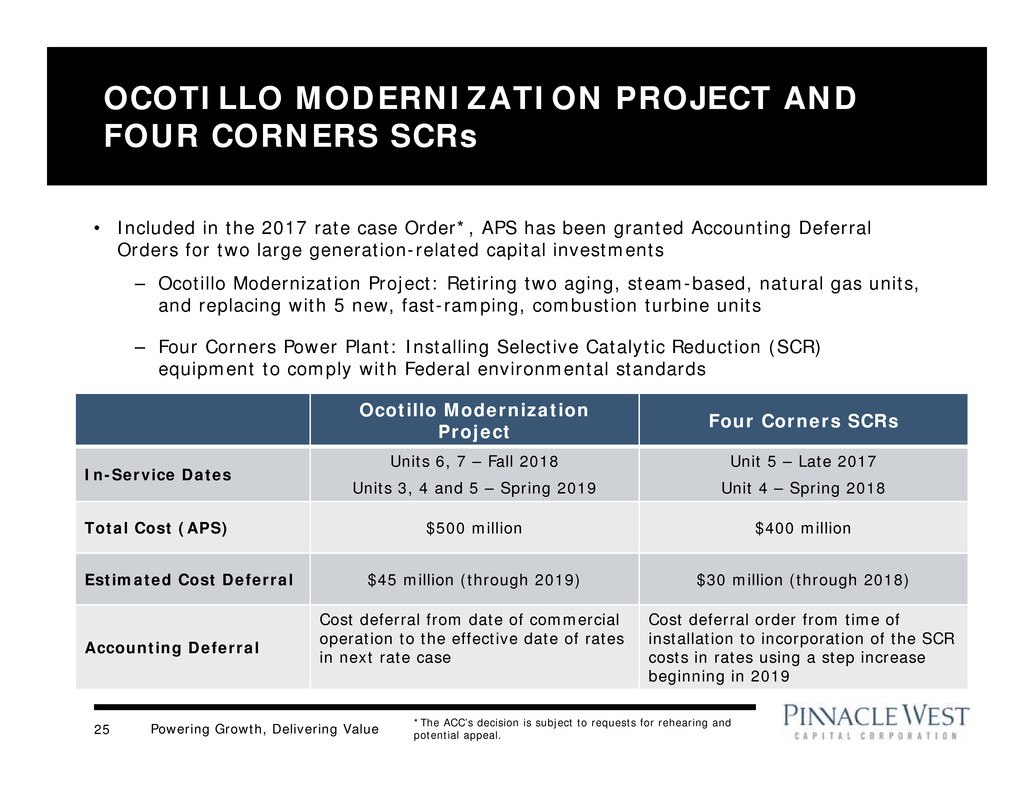
Powering Growth, Delivering Value25
OCOTILLO MODERNIZATION PROJECT AND
FOUR CORNERS SCRs
Ocotillo Modernization
Project Four Corners SCRs
In-Service Dates
Units 6, 7 – Fall 2018
Units 3, 4 and 5 – Spring 2019
Unit 5 – Late 2017
Unit 4 – Spring 2018
Total Cost (APS) $500 million $400 million
Estimated Cost Deferral $45 million (through 2019) $30 million (through 2018)
Accounting Deferral
Cost deferral from date of commercial
operation to the effective date of rates
in next rate case
Cost deferral order from time of
installation to incorporation of the SCR
costs in rates using a step increase
beginning in 2019
• Included in the 2017 rate case Order*, APS has been granted Accounting Deferral
Orders for two large generation-related capital investments
– Ocotillo Modernization Project: Retiring two aging, steam-based, natural gas units,
and replacing with 5 new, fast-ramping, combustion turbine units
– Four Corners Power Plant: Installing Selective Catalytic Reduction (SCR)
equipment to comply with Federal environmental standards
*The ACC’s decision is subject to requests for rehearing and
potential appeal.

Powering Growth, Delivering Value26
2017 KEY DATES
ACC Key Dates / Docket # Q1 Q2 Q3 Q4
Key Recurring Regulatory Filings
Lost Fixed Cost Recovery
E-01345A-11-0224 Jan 15
Transmission Cost Adjustor
E-01345A-11-0224 May 15
2018 DSM/EE Implementation Plan
E-01345A-17-0134 Sep 1
2018 RES Implementation Plan
E-01345A-17-0224 Jul 1
Decision expected by
end of 2017
APS Rate Case
E-01345A-16-0036
Aug 18: Decision No. 76295
Aug 19: Effective Date of Rates
Resource Planning and Procurement
E-00000V-15-0094
April 10: Final
2017 IRP Oct 1: Staff Report Due
Reducing System Peak Demand Costs
E-00000J-16-0257 --------------- TBD ---------------
Review, Modernization and Expansion of
Arizona Renewable Energy Standards
E-00000Q-16-0289
--------------- TBD ---------------
Inquiry into the Role of Forest Bioenergy
in Arizona
E-00000Q-17-0138
10/19: Workshop
11/18: Report due
Review and Modification of Current Net
Metering Rules
RE-00000A-17-0260
--------------- TBD ---------------
Other Key Dates Q1 Q2 Q3 Q4
Arizona State Legislature In session Jan 9 – May 10 (Adjourned)

Powering Growth, Delivering Value27
ENVIRONMENTAL
PLAN
Regional Haze compliance is the
biggest driver of environmental
spend over the next few years
Regional Haze / BART
(SCR)
Mercury and Other Hazardous
Air Pollutants
(ACI + Baghouse)
Coal Combustion Residuals
EPA Ruling Announced in 1999, with site-specific requirements announced more recently
MATS compliance by April 2015,
with potential for
one-year extension
Announced on December 19,
2014 (Subtitle D)
Four
Corners
Units 4 & 5
Approximately $400M for SCRs in 2016-2018
(does not include CAPEX related to 4CA 7%
interest)
$0
APS estimates its share of
incremental costs to comply
with the CCR rule for Four
Corners is approximately $22
million, and its share of
incremental costs for Cholla is
approximately $20 million.
APS expects to incur certain of
these costs during 2016-2018
timeframe.
Cholla
Units 1-3
On April 26, 2017, APS’s BART Reassessment for
Cholla took effect, which avoids the need for
additional pollution controls. This BART
compliance approach required the closure of Unit
2 by April 2016 and the cessation of coal-burning
for Units 1 and 3 by April 2025.1
$8M
Navajo
Units 1-32
Up to ~$200M for SCRs and baghouses; on
March 20, 2017, the Ninth Circuit Court of
Appeals denied petitions for review challenging
this better-than-BART compliance alternative
Approximately $1M Approximately $1M
Note: Dollars shown at ownership. Estimates as of June 30, 2017.
• Cholla: Unit 1 is not BART-eligible; Unit 2 retired on October 1, 2015; Unit 4 is owned by PacifiCorp.
• SO2 NAAQS and greenhouse gas-related costs will be determined based upon EPA rule makings, with no spend occurring before 2016.
• ACI = Activated Carbon Injection; NAAQS = National Ambient Air Quality Standard; SCR = Selective Catalytic Reduction control
technology
1 Because the parties opposed to this BART compliance approach did not file petitions for review as to the EPA’s final rule, the Cholla BART
Reassessment is now effectively final without risk of further judicial intervention.
2 On February 13, 2017, the co-owners of the Navajo Plant voted not to pursue continued operation beyond December 2019, the
expiration of the current lease term.
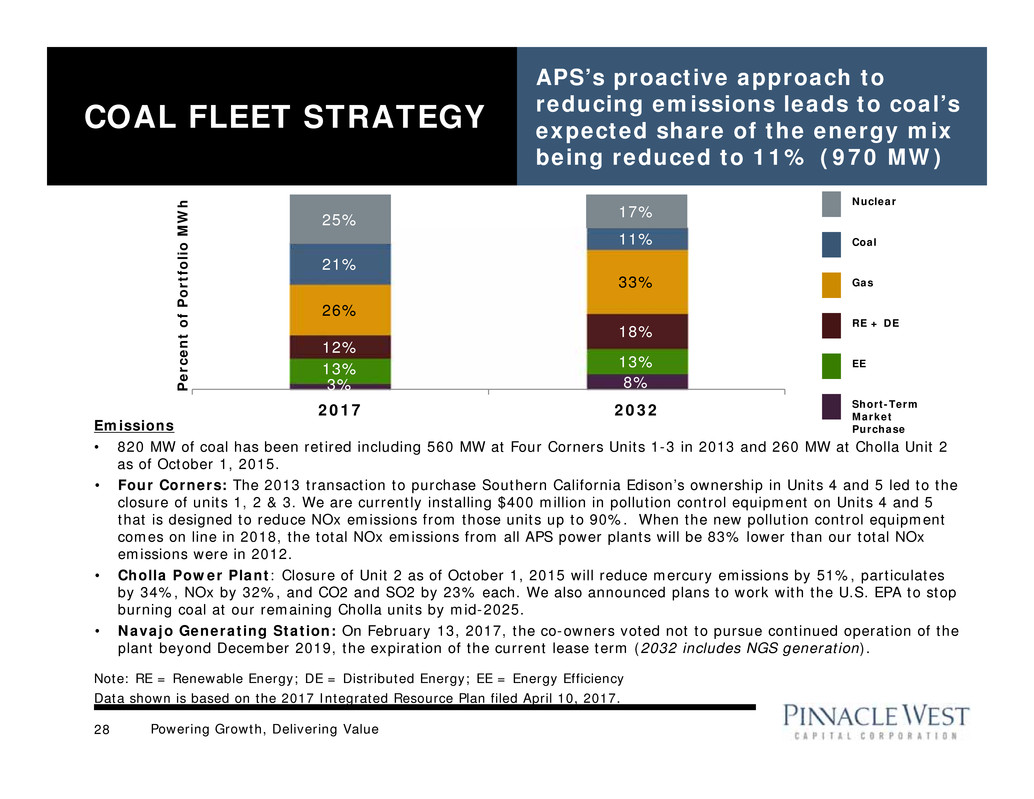
Powering Growth, Delivering Value28
Emissions
• 820 MW of coal has been retired including 560 MW at Four Corners Units 1-3 in 2013 and 260 MW at Cholla Unit 2
as of October 1, 2015.
• Four Corners: The 2013 transaction to purchase Southern California Edison’s ownership in Units 4 and 5 led to the
closure of units 1, 2 & 3. We are currently installing $400 million in pollution control equipment on Units 4 and 5
that is designed to reduce NOx emissions from those units up to 90%. When the new pollution control equipment
comes on line in 2018, the total NOx emissions from all APS power plants will be 83% lower than our total NOx
emissions were in 2012.
• Cholla Power Plant: Closure of Unit 2 as of October 1, 2015 will reduce mercury emissions by 51%, particulates
by 34%, NOx by 32%, and CO2 and SO2 by 23% each. We also announced plans to work with the U.S. EPA to stop
burning coal at our remaining Cholla units by mid-2025.
• Navajo Generating Station: On February 13, 2017, the co-owners voted not to pursue continued operation of the
plant beyond December 2019, the expiration of the current lease term (2032 includes NGS generation).
COAL FLEET STRATEGY
APS’s proactive approach to
reducing emissions leads to coal’s
expected share of the energy mix
being reduced to 11% (970 MW)
3% 8%
13% 13%
12%
18%
26%
33%
21%
11%
25% 17%
2017 2032
P
e
r
c
e
n
t
o
f
P
o
r
t
f
o
l
i
o
M
W
h
Note: RE = Renewable Energy; DE = Distributed Energy; EE = Energy Efficiency
Data shown is based on the 2017 Integrated Resource Plan filed April 10, 2017.
Gas
Coal
Nuclear
RE + DE
EE
Short-Term
Market
Purchase

Powering Growth, Delivering Value29
WATER STRATEGY
APS, and Palo Verde in particular,
has provided national and
international leadership on the
use of reclaimed water for power
generation
74%
13%
13%
Reclaimed Water
Groundwater
Surface Water
APS 2016 Fleet
Water Use By Source Type
Vision: APS continues to strive for sustainable and cost-effective water supplies for energy production
for APS customers.
Mission: To execute a strategic water resource management program that provides APS timely and
reliable information to manage our water resources portfolio efficiently and effectively, and helps
ensure long-term water supplies and water contingency plans for each of our facilities, even in times of
extended drought.
• Each APS power plant has a unique water strategy, developed to promote efficient and sustainable
use of water. In 2016, we reduced groundwater use by 28% compared to 2014 usage, far
surpassing our goal of 8%.
Water Usage and Intensity: Over the next 10 years, our goal is
to reduce water intensity company-wide by 20% compared to a
2014 baseline. Our current initiatives include:
• Reducing consumption of non-renewable water resources by
10% in 2017 over 2014 baseline, and
• Reducing consumption of non-renewable water resources by
12% in 2018 over 2014 baseline.
Palo Verde Generating Station: The only nuclear power plant
in the world that is not located next to a large body of water.
Instead, it uses treated effluent, or wastewater, from several area
municipalities, recycling approximately 20 billion gallons of
wastewater each year
Ocotillo Modernization Project: State-of-the-art hybrid cooling
technology for new units being constructed will decrease water
use from 900 gallons per MWh to 140 per gallon, a reduction of
more than 80%.

Powering Growth, Delivering Value30
GENERATION PORTFOLIO*
Plant Location No. of Units Dispatch COD Ownership Interest1 Net Capacity (MW)
NUCLEAR
1,146 MW Palo Verde Wintersburg, AZ 3 Base 1986-1989 29.1% 1,146
COAL
1,672 MW
Cholla Joseph City, AZ 2 Base 1962-1980 100 387
Four Corners Farmington, NM 2 Base 1969-1970 63 970
Navajo Page, AZ 3 Base 1974-1976 14 315
GAS - COMBINED CYCLE
1,871 MW
Redhawk Arlington, AZ 2 Intermediate 2002 100 984
West Phoenix Phoenix, AZ 5 Intermediate 1976-2003 100 887
GAS - STEAM TURBINE
220 MW Ocotillo Tempe, AZ 2 Peaking 1960 100 220
GAS / OIL
COMBUSTION TURBINE
1,088 MW
Sundance Casa Grande, AZ 10 Peaking 2002 100 420
Yucca Yuma, AZ 6 Peaking 1971-2008 100 243
Saguaro Red Rock, AZ 3 Peaking 1972-2002 100 189
West Phoenix Phoenix, AZ 2 Peaking 1972-1973 100 110
Ocotillo Tempe, AZ 2 Peaking 1972-1973 100 110
Douglas Douglas, AZ 1 Peaking 1972 100 16
SOLAR
239 MW
Hyder & Hyder II Hyder, AZ - As Available 2011-2013 100 30
Paloma Gila Bend, AZ - As Available 2011 100 17
Cotton Center Gila Bend, AZ - As Available 2011 100 17
Chino Valley Chino Valley, AZ - As Available 2012 100 19
Foothills Yuma, AZ - As Available 2013 100 35
Distributed Energy Multiple AZ Facilities - As Available Various 100 25
Gila Bend Gila Bend, AZ - As Available 2015 100 32
Luke Air Force Base Glendale, AZ - As Available 2015 100 10
Desert Star Buckeye, AZ - As Available 2015 100 10
Red Rock Red Rock, AZ - As Available 2016 100 40
Various Multiple AZ Facilities - As Available 1996-2006 100 4
Total Generation Capacity 6,236 MW
1 Includes leased generation plants* As disclosed in 2016 Form 10-K.

Powering Growth, Delivering Value31
PURCHASED POWER CONTRACTS*
Contract Location Owner/Developer Status1 PPA Signed COD Term (Years) Net Capacity (MW)
SOLAR
310 MW
Solana Gila Bend, AZ Abengoa IO Feb-2008 2013 30 250
RE Ajo Ajo, AZ Duke Energy Gen Svcs IO Jan-2010 2011 25 5
Sun E AZ 1 Prescott, AZ SunEdison IO Feb-2010 2011 30 10
Saddle Mountain Tonopah, AZ SunEdison IO Jan - 2011 2012 30 15
Badger Tonopah, AZ PSEG IO Jan-2012 2013 30 15
Gillespie Maricopa County, AZ Recurrent Energy IO Jan-2012 2013 30 15
WIND
289 MW
Aragonne Mesa Santa Rosa, NM Ingifen Asset Mgmt IO Dec-2005 2006 20 90
High Lonesome Mountainair, NM Foresight / EME IO Feb-2008 2009 30 100
Perrin Ranch Wind Williams, AZ NextEra Energy IO Jul-2010 2012 25 99
GEOTHERMAL
10 MW Salton Sea Imperial County, CA Cal Energy IO Jan-2006 2006 23 10
BIOMASS
14 MW Snowflake Snowflake, AZ Novo Power IO Sep-2005 2008 15 14
BIOGAS
6 MW
Glendale Landfill Glendale, AZ Glendale Energy LLC IO Jul-2008 2010 20 3
NW Regional Landfill Surprise, AZ Waste Management IO Dec-2010 2012 20 3
INTER-UTILITY
540 MW
PacifiCorp Seasonal
Power Exchange - PacifiCorp IO Sep-1990 1991 30 480
Not Disclosed Not Disclosed Not Disclosed IO May-2009 2010 10 60
CONVENTIONAL
TOLLING
1,639 MW
CC Tolling Not Disclosed Not Disclosed IO Mar-2006 2007 10 514
CC Tolling Not Disclosed Not Disclosed IO Aug-2007 2010 10 560
CC Tolling Arlington, AZ Arlington Valley IO Dec-2016 2020 6 565
DEMAND RESPONSE
25 MW Demand Response Not Disclosed Not Disclosed IO Sep-2008 2010 15 25
Total Contracted Capacity 2,833 MW
1 UD = Under Development; UC = Under Construction; IO = In Operation* As disclosed in 2016 Form 10-K.

Powering Growth, Delivering Value32
INVESTOR RELATIONS CONTACTS
Paul J. Mountain, CFA
General Manager, Investor Relations & Audit Services
(602) 250-4952
paul.mountain@pinnaclewest.com
Stefanie Layton
Director, Investor Relations
(602) 250-4541
stefanie.layton@pinnaclewest.com
Chalese Haraldsen
(602) 250-5643
chalese.haraldsen@pinnaclewest.com
Pinnacle West Capital Corporation
P.O. Box 53999, Mail Station 9998
Phoenix, Arizona 85072-3999
Visit us online at: www.pinnaclewest.com
